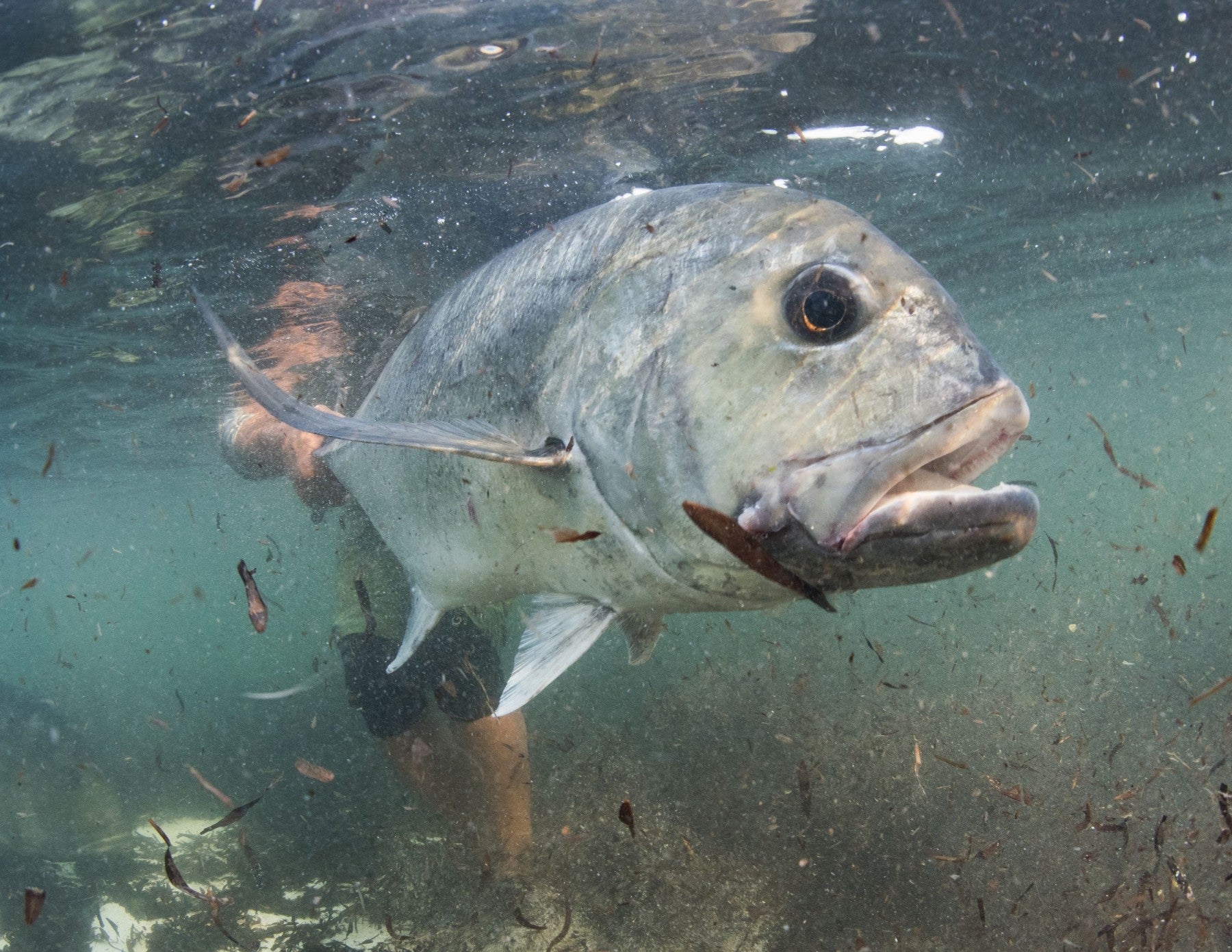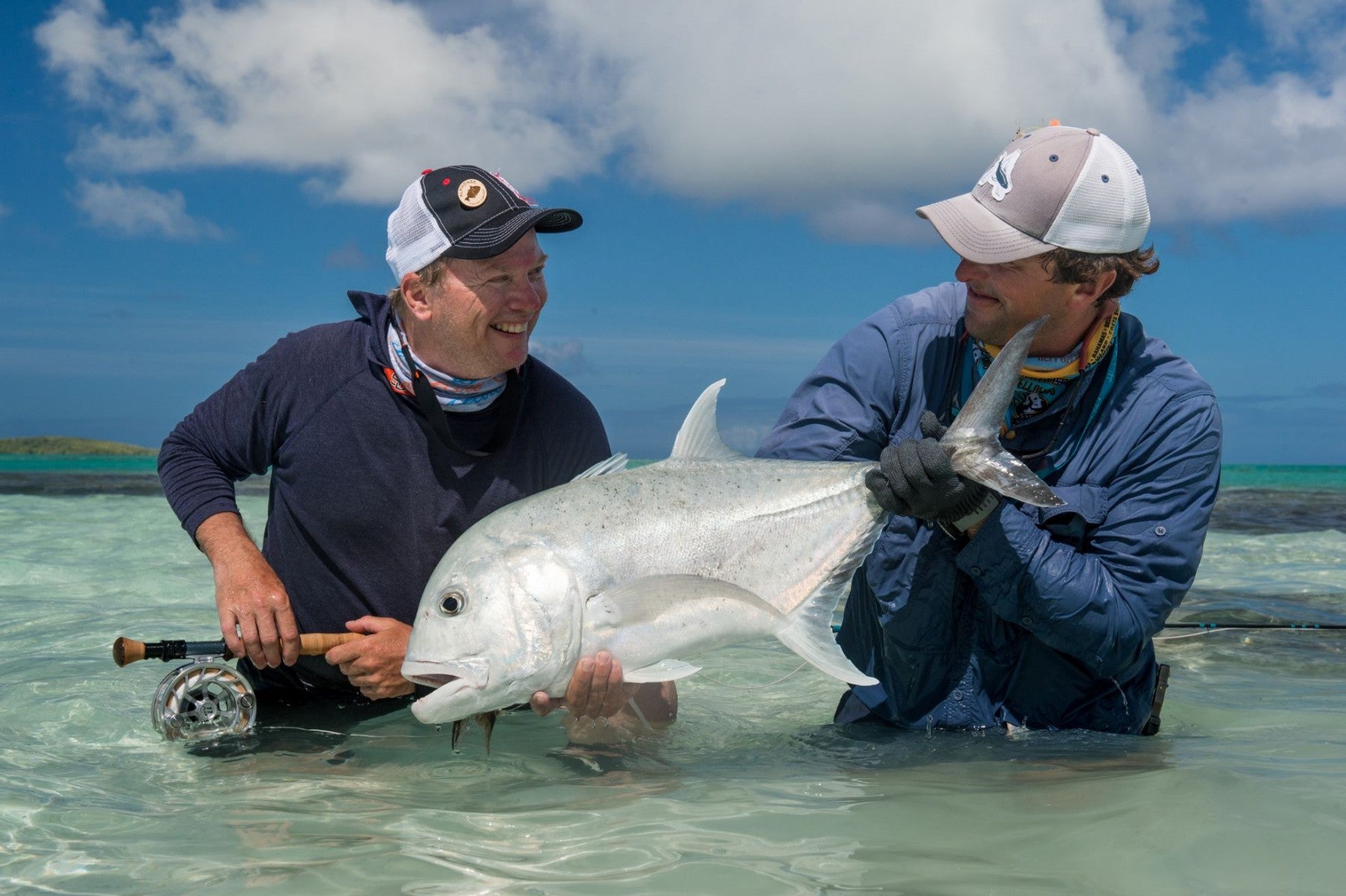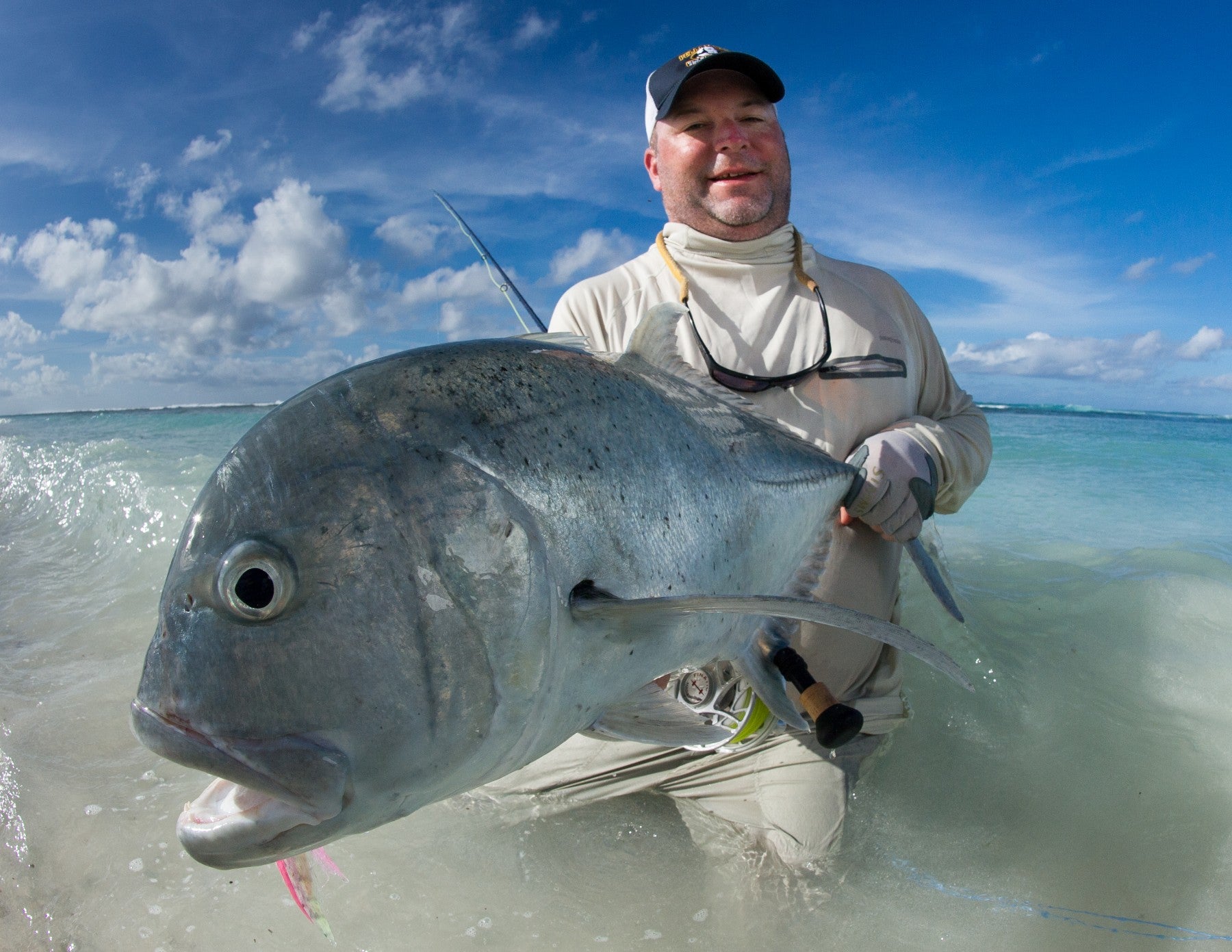If a perfect saltwater fly fishing species were to be created, a Giant Trevally, also called GT’s or Geets, could top the list. GT’s are aggressive, fast, powerful, and willing to eat a well-presented fly. Stalking, casting to, fighting, and landing one of these fish is an angling accomplishment. Fortunately, with our angling adventures and expertise, a Geet on a fly is attainable. Yellow Dog Flyfishing Adventures is proud to offer a wide selection of Giant Trevally fly-fishing trips at unique destinations around the globe.
What is a Giant Trevally?

An apex predator. A brute among saltwater flats species. An aggressive, large, and powerful fish. These attributes make Giant Trevally (Caranx ignobilis) an ideal gamefish, averaging over 40 inches in length, nearly 30 pounds, and can swim up to 37 miles per hour. With large eyes and a wide mouth, these fish prey on whatever they can find—crabs, lobsters, shrimp, eels, birds…yes, birds…and whatever else they can devour. Their reputation as a flats species is one of voracity and thuggery.

Where Are They Found?
Widely distributed throughout the Indo-Pacific tropical waters from South Africa to Hawaii, including large populations in the Seychelles and parts of Australia, GTs cover a broad range. GTs can be found in estuaries, shallow flats, bays, or lagoons. As they grow to full maturity, usually around six to seven years, they can be found near deeper reefs or remote atolls.
More specifically, these “Gangsters of the Flats” can be found in the Cook Islands, Christmas Island, Australia, the Seychelles, and St. Brandon’s Atoll. To add to the thrill of casting to, and hopefully fighting one of these bruisers, these destinations are serviced by a range of lodges across all budgets and all have experienced, safe and hard-working guides.

What makes a Geet so special to catch on a fly rod?
Crystal clear saltwater flats or reefs. Ocean waters with greens and blues so vibrant they must be seen in person. And in the middle of all of this live GT’s—a large predator ranging in size from 20 to over 100 pounds, and once found, can eat with reckless abandon featuring violent takes. Despite a GT’s willingness to crush a well, and timely presented fly, they don’t always come easy.
Most GT destinations require a commitment—a long travel itinerary often involving a lengthy overnight flight; additional charter flights or long boat transfers; and the desire for exploration, adventure, and embracing remoteness; and that is before the first cast is made to the first fish that is spotted.
Many opportunities come while fishing from a boat or while wading. If a fish is spotted, either from the boat or while wading, a plan must be quickly be made. Often anglers will exit the boat and enter the water—the angler and the fish are now in the same element and the playing field is leveled. Once in casting range, good casting skills are essential. If the fish sees the fly and moves to take it, an angler must remain calm in the face of extreme excitement. If a take occurs, it is a back-alley battle of the fittest to out-muscle, out-brawn, and out-last a Geet as they make several hard-charging runs.

Gear and tackle for fishing for Giant Trevally
These fish will test even the best rods, reels, fly lines and leaders. Planning for at least one broken rod and a broken fly line per trip are common. If normal saltwater fishing demands quality gear, then Giant Trevally fly fishing epitomizes selecting the best gear available—which means being ok to invest money in high-quality gear.
Rods for Giant Trevally Fly fishing
Most fishing occurs with 11 and 12-weight rods. 10 weights can be used for smaller Geets, but, should a larger GT come into casting range, this is like bringing a knife to a gunfight. 11 and 12-weight rods are big rods and casts to GTs happen fast and furious. Being comfortable with a big fly rod is essential to out-thugging a large Geet; before a Giant Trevally fly fishing trip, committing to an hour or more of casting practice a week will pay off.

Reels for GT fishing
When anglers rig gear on day one of a week-long GT trip, seasoned GT fishing guides head straight to anglers’ reels. In the boxing match that is fishing for these fish, if the rod is the jab, the reel is the uppercut—the opponent won’t be bested without a good one.
Reels for Giant Trevally fly fishing must be large arbor and be able to hold at least 300 yards of 80-pound braided backing with an 11, 12, or 13-weight fly line. Reels need to be this large to aid in quick line retrieval and hold plenty of backing. A quality drag system, and its ability to get to maximum stopping power as fast as possible, is crucial to whipping a GTs spirit early in the fight.
Most reel manufacturers make quality reels with the arbor diameter and backing capacity to handle the biggest GT’s…at least once. But, there is a difference for even quality reels in catching one large GT and still holding up after GT number ten while holding-up in the harsh saltwater flats conditions.

Fly lines for Giant Trevally fly fishing
+ Click here for recommended GT Fly Lines
As more anglers pursue GT’s on a fly, fly line companies have followed suit. And, this is a very good thing. A Geet fly line must have a powerful front taper to cast large flies, often into gnarly winds. A shorter, heavier head of the fly line helps load the required powerful rods needed for GT fishing. Shorter and more powerful front tapers are not necessarily new to fly lines, but, what is new for the GT-specific lines are stronger, more durable cores. A heavier core holds up better in hot saltwater environments and may be less likely to get cut on coral heads.
But as fly line companies have worked to make fly fishing for GT's a tad easier, they've also done one thing wrong: the fused loop at end of the front taper at which to attach the leader. The first thing any experienced Geet guide will do is cut that loop and loop the butt section with a new hand-tied loop in the fly line. The fused loop has a high failure rate versus a hand-tied loop.
Because Giant Trevallys often live where coral heads and abundant, and GT’s are just downright big and fast, a fly line must be able to withstand the occasional brush with coral and the demands a 100-pounds of pissed-off apex predator fury.
The best way to rig—this isn’t your grandmother’s saltwater fishing
Armed with the correct rod and reel, leader and tippet selection are relatively simple. Because Geets have abrasive mouths and live amongst coral heads and reefs, when hooked they must be stopped in their tracks as soon as possible. Don’t let an 80-pound leader and tippet be the reason a catch of a lifetime is lost. Self-made 9-foot 80 or 100-pound fluorocarbon leaders and tippets should be used.
Learn an improved Homer Rhodes loop knot and use that to attach the fly line to the butt section and for the tippet to fly. Some anglers prefer a Bimini twist for fly line to butt section. Because coral heads and reef edges are unforgiving on fly lines or butt sections, there is no need for a wire bite tippet. 80 to 100-pound fluorocarbon is durable but strong enough to slow down even the largest Geet. With a leader and tippet that strong, fly hooks are more likely to bend, causing a fish to gain its freedom

The Top Flies For Giant Trevally
Fly selection should be based on the specific area to be fished. Flies should be big, full-bodied and match the available prey. Generally, lighter colored flies should be used on white sand areas and darker colors are best for surf areas or habitat with a variety of coral heads and exposed reefs. Lighter color flies imitate mullet, small trevally and bream. Darker flies imitate grouper, reef fish, snapper and emperor fish. Here are four of our favorites.
EP’s GT’s Baitfish. Very similar to the Black Brush Fly, created by Enrico Puglisi, this fly cast well in the wind and is durable for several fish. EP’s flies are known for quality and producing fish. Tied with large eyes and just a hint of red in the thorax to simulate gills on a baitfish, this fly imitates a fleeing baitfish—exactly what they’d do if a Geet is on the prowl. Available in a variety of color combinations, most GT’s are caught on Black & Purple or Bleeding Black, which is a specific combo of black and red.
Black Brush Fly. Especially effective in the Seychelles, the Black Brush Fly may be responsible for more GT’s to hand than any other fly pattern. Similar to EP’s GT’s Baitfish this fly has an over-sized eye, imitating the look of prey when they feel a predator near-by. Brush flies can be tied with and without eyes and contrasting colors. Solid black, brown, or grey are effective, as are any contrasting combos of black, purple, red, chartreuse, and grey.
GT Semper Fly. Tied with Puglisi fibers in the head and well-matched hackles as the tail, this variation of the Bob Popovic’s Semper Fly, is ideal for GT’s. Think of it as the traditional Semper Fly on steroids. The EP fibers and hackles make an irresistible motion in the water. This fly is best fished when stripped long and cast in front of cruising Geets.
A favorite popper. Choose poppers large enough to get a GT’s attention. Casting a popper is never easy, especially given most GT’s live in windy environments. But if all factors line-up appropriately, a popper can elicit exciting top-water takes. Most often fished over deeper waters, in lagoons, and in channels or cuts, the disturbance created by a popper could signal a baitfish in distress and near-by predators may respond.

Fishing Tactics for Giant Trevally
On any given day a variety of tactics may be used. These fish are predators and actively seek out prey. During a pushing tide—or water rising onto a flat—GT’s feel comfortable with rising water compared to a falling tide and water draining the flats. But during a falling tide GT’s may congregate in areas where prey are coming off the flats with the dropping water. Flats, lagoons, coral heads, channels, and cuts may all be fished on any day.

Sight-fishing for GT’s—spot and stalk
Many Geets are spotted while cruising in a boat or walking the flats. If spotted while cruising from a boat, an angler will quietly exit the boat and continue stalking the predator on foot. If walking the flats, anglers constantly scan the scene for any sign of a Geet—nervous water, a tail, fleeing baitfish or cruising shadows. Once a fish is spotted, whether in the boat or on foot, the drama begins. Little time can be wasted to move within casting distance, but frantic running or splashing should be avoided as any proper Geet will sense the movement and slide back to the safety of deeper waters. Once in casting range, a good double haul and an accurate presentation are key.
Presenting Your Fly To Giant Trevally
Geets do not tend to be selective, but they are acutely aware of their surroundings. A bad cast—too long or over a fish—is likely to spook even the most aggressive fish. The fly should never land behind or to the side of a fish, as rarely does a baitfish swim towards a large predator. A quiet, yet authoritative presentation cast is often the most effective. This is best accomplished by striving to lead a feeding or cruising GT by three to four-rod lengths. When shooting line on the presentation cast, it is crucial to keep the line-hand in contact with the fly line at all times because of the need to immediately strip the fly may be necessary. Strip in long, deliberate strips, waiting patiently while adrenaline builds

How to fight Giant Trevally on a fly rod
When the fish eats the fly, the long strip will stop, and stop hard. Set the hook with conviction, like a one-handed tug to finish off a tug-of-war opponent. Keep the rod tip pointed down during the initial take and setting of the hook. Only when the Geet is on the reel should the rod be raised. Most GT’s will run hard and long, reaching into the backing multiple times during a fight. Be prepared to run, sweat, grunt, and eventually reveal in delight as the fight with a Giant Trevally is the total sum of all the parts leading up to the moment a fish is landed

Best times of year
Pursuing GT’s year-round is possible, but, like any species, there are times when environmental factors are more favorable for angling success. Tides, winds, rain or lack thereof, and available baitfish all should be considered when choosing a destination. At Yellow Dog Flyfishing Adventures, our opportunities are varied, but still, require being in the right place at the right time.
- Christmas Island. Year-round.
The shallow water flats of Christmas Island are teeming with bonefish, triggerfish, GT’s and numerous other gamefish. While the accommodations are modest the fishery itself is diverse and will offer up many opportunities at GT’s for those willing to dedicate the time. Yellow Dog Flyfishing Adventures’ Christmas Island destinations are dedicated fishing lodges and ideally suited for anglers desiring a fishing-focused trip.
- Seychelles. August through May.
Arguably the global capital for opportunities for GT’s on a fly, the shallow waters of Seychelles offer unbelievable wading and amazing fly-fishing opportunities for an incredible number of different species. As for the incredible Giant Trevally action that is found throughout the islands, we can confidently say that there is nothing else that compares in the entire world of fly fishing. -
Australia. Year-round.
Australia is a land like no other, boasting spectacular landscapes and rich ancient culture. With tropical waters in the north and a temperate climate in the south, it provides unique fly-fishing opportunities and a diversity of species that are found nowhere else in the world. The opportunities to fly fish for Giant Trevally in Australia are plentiful. - Cook Island. February and March.
These islands, accessed via an easy seven-hour flight from Los Angeles, are home to friendly and welcoming locals and the islands are resplendent in rich traditions passed down from their Tahitian ancestors as well as many of their own….and they are home to Giant Trevally willing to crush a fly.
Whether a Giant Trevally on a fly is another notch in the angling belt or an angling addiction that needs to be fed, Giant Trevally is fierce, big, aggressive and incredibly powerful saltwater fish. They live in a variety of unique places across a range of budgets. But, fishing for GTs is not for the faint-hearted angler, because these powerful fish will test every piece of gear as well an angler’s commitment to improving their skills and their mettle for travel to far-off, invigorating destinations.
But the reward of grasping one of these stellar fish by the tail is worth the effort.
Related Articles:
- The 8 Best Bonefishing Destinations in the World
- Guide Talk: How to Come Prepared for a Seychelles Fishing Trip
- An In-Depth Guide to Fly Fishing for Giant Trevally
- Seychelles: 5 Outstanding and Remote Saltwater Fly Fishing Atolls
- Coming Prepared with the Right Saltwater Flats Clothing
- Seychelles Fly Fishing Gear Guide: Everything You Need





























